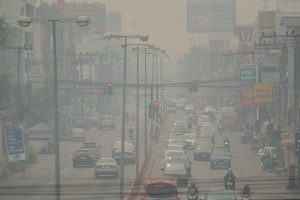A record heatwave combined with intense smoke from burning off cropland has created the worst living conditions in memory across mainland Southeast Asia, amid long-range weather forecasts that this year’s dry season will last longer than usual, to be followed by less rain than usual.
Temperatures are routinely exceeding 40 degrees Celsius in Myanmar, Thailand, Laos, and Cambodia, stoking fears that the heavy rains last year – which prompted the Mekong River Commission to declare a four-year drought over – were just a short respite.
Chiang Mai, hemmed in by mountains, has fared worse, with annual burning in northern Thailand and nearby Myanmar choking off the city, forcing thousands to flee. It is now ranked as the most polluted city on the planet, ahead of Lahore, Tehran, and Beijing.
On Friday, Bangkok warned people not to go outside as the mercury climbed to 45 degrees C and the national weather service said the heat index, which is what the temperature feels like when it is combined with humidity levels, hit a record 54 degrees C.
Somkhwan Tanchan, director of the Thai Meteorological Observations Division, said that maximum temperatures had averaged around 40 degrees C since the beginning of April – and that the severity of “an upcoming drought” is more concerning than the big dries of 2019 and 2020.
Blackouts and water shortages are common as electricity grids buckle under intense use of air conditioners and refrigeration while heavy demand for water has resulted in chronic shortages in neighboring Cambodia, which will stage the Southeast Asian Games from May 5-17.
How the athletes will fare is a major concern for organizers, given that weather historian Maximiliano Herrera described the current climatic conditions as the “worst April heat wave in Asian history.”
The burning season, when farmers slash and burn large tracts of land before planting crops across mainland Southeast Asia, typically lasts for about two months and ends with the wet season.
However, in Cambodia, the Ministry of Water Resources and Meteorology has issued its second long-term weather forecast for 2023 – and it says hot weather will continue until mid-May, later than expected, and with less rain anticipated than in 2022
It said weather patterns were being impacted by the El Nino heat phenomenon, which is currently transitioning between El Nino and La Nina. The resulting heat is expected to last until well into August.
As a result, the rainy season will arrive in the second week of May, later than 2022, with only light to moderate and scattered rainfall. From August to September, only light to moderate rainfall and partly moderate rainfall is expected.
Importantly, the Cambodian ministry added that rainfall is expected to be “20 percent to 30 percent lower than the average for many years,” which effectively means a return to drought conditions.
“In the rainy season of 2023, Cambodia will face the risk of a dry season that can last from early July to early August,” the ministry said.
It’s a forecast that can be applied in equal measures to southern Vietnam, Laos, Thailand, and Myanmar. If correct, the resulting drought will potentially have a devastating impact on the 70 million people who rely on the Mekong River for their livelihoods.
That will also increase diplomatic pressure on China and Laos – given the sheer scale of dam construction over the last two decades – to maintain water flow into the lower Mekong region, which includes Thailand, Cambodia, Laos, and Vietnam.
In mid-2020, a report by research company Eyes on Earth Inc. accused China of water hoarding, a charge denied by Beijing, with fisherman and farmers bitterly complaining about low fish catches and poor harvests as result.
“This year is looking much worse than previous years, I wouldn’t have thought that possible,” one Bangkok resident said. “The heat and smoke make any type of physical work impossible – all one can do is cough, wheeze, and sweat, stay indoors, and run the air conditioners.”

































